Rolling stock • Block train • High speed train • Italy • NTV-Italo • AGV Alstom
➤ See also: Avelia Horizon – ETR 400 (Frecciarossa 1000) – ICE 4
Note: For educational purpose only. This page is meant purely as a documentation tool and has no legal effect. It is not a substitute for the official page of the operating company, manufacturer or official institutions. It cannot be used for staff training, which is the responsibility of approved institutions and companies.
Read the full package on NTV-Italo:
The company → AGV Alstom ETR 575 → Pendolino ETR 675 → Train services → Economics
On this page:
➤ Background and development
➤ Technical details
➤ On-board comfort: NTV-Italo’s choices
➤ Club Executive ambiance
➤ Prima ambiance
➤ Smart ambiance
➤ Launch and management
In brief
The AGV was designed before the 2008 financial crisis, when the high-speed rail market was expanding. With market demands for trains covering over 1,000 km in under three hours, speeds of 360 km/h were envisioned. However, Alstom’s AGV no longer suited the SNCF, which preferred high-capacity TGV-Duplex and 2N2 models to increase seating without adding trains and incurring extra rail tolls.
The AGV had been part of a joint bid by Alstom and CAF for the Madrid-Barcelona line, but the contract went to Talgo and Siemens. Siemens’ argument for maximizing seating capacity influenced Alstom’s design, which retained the articulated TGV architecture. The first prototype, Elisa, emerged in 2001, followed by Pégase.
Unexpectedly, the AGV’s first customer was Italy’s private operator NTV, founded in 2006. Initially considering Siemens’s ICE, NTV’s CEO discovered Pégase at Alstom’s La Rochelle facility in 2007. In January 2008, NTV ordered 25 ETR 575 trainsets, delivered between 2011 and 2012, with a 30-year, €1.5 billion maintenance contract in Nola, near Naples.
NTV’s AGV featured 11 articulated cars, 200 meters long, with a 410-ton weight. It had 10 permanent magnet motors (7,500 kW) and could reach 300 km/h, or 360 km/h with additional powered bogies. The interior, optimized for space, included Club, Prima, and Smart “atmospheres,” seating 450 passengers.
The first train was delivered in 2010, entering service as NTV-Italo in April 2012. While Alstom’s AGV future remains uncertain, NTV later ordered eight Pendolino trains in 2015.
Family name: AGV (Avelia Alstom)
Class: ETR 575 (Italy)
Manufacturer(s): Alstom
Train type: Trainsets
Sector: Passengers transport
Type of service: Main line
Operator(s): NTV-Italo (25)
First services: April 2012
————————
Train length: 200m
Maximum speed: 300 km/h
Traction system: floor-mounted Alstom ONIX IGBT-VVVF
Electric system(s): 25 kV 50 Hz AC, 3,000 V DC
Pantograph: 2
Braking system(s): Dynamic and Regenerative brake
Track gauge: 1,435 mm
————————
Formation: 11 cars – Four class
Seats Club Executive: 19
Seats Prima: 76
Seats Comfort: 76
Seats Smart: 289
Restaurant car: no
Bar car: no
Total seats: 460
The definition of a high-speed train varies by region, but generally, it refers to trains that operate at speeds of at least 250 km/h (155 mph) on newly built lines and 200 km/h (124 mph) on upgraded lines. In Europe, for example, the UIC (International Union of Railways) considers a commercial speed of 250 km/h as the principal criterion for high-speed rail. In the United States, the definition can include trains operating at speeds ranging from 180 km/h (110 mph) to 240 km/h (150 mph).
➤ See the UIC definition
In addition, the european’s TSI gives two high-speed classes (according 2008/232/EC point 4.2.1.1 b) :
• Class 1: trains with a maximum speed of 250 km/h or more;
• Class 2: trains with a maximal speed of at least 190 km/h, but less than 250 km/h.
Background and development
The story goes that the future CEO of NTV, Giuseppe Sciarrone, arrived at Alstom La Rochelle one fine day in March 2007 for information, and discovered the Pegasus prototype in the workshop, still in the skeleton stage. He was shown the development of the AGV, an ‘Automotrice à Grande Vitesse‘.
On 17 January 2008, before the official presentation by Alstom, which took place in February, NTV-Italo placed an order with Alstom for the construction of 25 trainsets built at the La Rochelle and Savigliano plants, a plant bought by Alstom in 2000 from Fiat Ferroviaria. The contract, worth €650 million, also included maintenance of the trains for a period of 30 years, although this was not included in the price. It also included an option for 10 additional trainsets. In NTV, Alstom found its first customer to launch its new product.
Giuseppe Sciarrone was proud to state that year that « the great innovation of the introduction of competition on the high-speed networks and the challenge of a new train is now close to becoming a reality. NTV is leading the way and, for once, we can say that Italy is the leader of a major innovation process. » On 5 February 2008, the first trainset was officially unveiled at Alstom Transport’s La Rochelle plant.
In the summer of 2008, the first prototype trainset was put through its paces on the 13-kilometre Velim ring in the Czech Republic, at a maximum speed of 200km/h. Nearly 15 Alstom engineers from the Group’s various industrial sites worked in shifts until September 2008 to carry out these tests.
Technical details
The AGV is the exact opposite of the SNCF’s preference: distributed motorisation and a single deck. It’s a genuine in-house product. Back in 2003, Alstom decided to anticipate market needs by launching a generation of very high-speed trains for customers other than the SNCF. The design of this AGV naturally drew on the French champion’s 30 years’ experience in very high speed, while opting here for financing from its own resources, without any specific customer specifications. Compatible with interoperability standards, the AGV was clearly aimed at international markets before the 2008 crisis hit…
NTV chose an 11-car articulated trainset, 200m long and weighing 410 tonnes. Distributed motorisation had been the subject of extensive research during tests with the Elisa and Pégase prototypes. The voltages selected were 25kV AC and 3kV DC. The 10 permanent magnet synchronous motors supply 7,500kW spread over five bogies. These motors have the same weight as the induction motors, but deliver much greater power.
Maximum speed is set at 300km/h with five motorised bogies, but can rise to 360km/h with six motorised bogies. Compared with the TGV, the height of the roof has been increased in order to increase the height of the interior space and accommodate equipment such as air conditioning units and braking resistors on the roof. Inside the train, the ceiling-mounted air conditioning system has freed up a few centimetres on the sides, giving an internal width of 2,750mm.
17 of the 25 trainsets were built in La Rochelle, the first of which was delivered at the end of 2010 and the second in May 2011. The last eight were manufactured in Savigliano, Alstom’s Italian plant. A test campaign led to the issue of an operating certificate in Italy. In October 2011, an NTV trainset carried out a series of tests on the Rhine-Rhone LGV, which is not yet open to service.
On-board comfort: NTV-Italo’s choices
Flanked by bosses from the worlds of Ferrari and Tod’s, the top of “Made in Italy”, NTV had to differentiate itself very clearly from the aborted low-cost attempt by Arenaways’ single-class trains. Here, chic comes in “three moods”, dominated by the red that symbolises Italian luxury… but also the colours of the big car brand! Despite this fine line-up, there was no mistaking it. « We had been identified as a company providing transport services for the elite, the top level. In reality, Italo is very different from Ferrari. Italo is the train for everyone, » says Giuseppe Sciarrone, who is hoping to attract a clientele used to low-cost aviation.
For its on-board services, NTV has adopted the multi-class concept already in vogue at Trenitalia and Renfe. In reality, there are no classes, but rather “ambiences” in line with the marketing spirit. The trains offer a Club carriage with just 19 seats (including two 4-seater lounges), four Prima carriages with a total of 143 cosy seats, six Smart carriages with 288 seats in 2+2 seating, the last of which is a Smart Cinéma carriage with 39 seats and eight high-definition screens. All in all, 450 seats spread over eleven cars, two of which have a driver’s cab at the ends, making the AGV a ‘high-speed self-propelled vehicle’.
In Italy, on a high-speed train, it is essential to have not only a free on-board Wi-Fi connection, but also an on-board portal that allows the company to broadcast free content for customers (films, newspapers, TV, series, tourist information, etc.). In the future, it may be possible to sign an agreement with a major TV series provider, such as Netflix, to offer customers a specific product and improve the quality of the offer. At the time, NTV’s CEO stressed that « the profitability of ancillary services is not important. Some services, for example, are at a loss (television, Wi-Fi) but we provide them free of charge because we believe they can be a service that makes us preferable to competitors. »
The plan below shows the situation of the trains since 2013, when 2 cars initially ‘Prima’ became ‘Smart XL’ then finally ‘Comfort’. The 460 seats over 200m give us the illusion of a higher ratio than an ICE3 or an SNCF TGV train, but this is due to the absence of a bar-bistro and/or restaurant on the Italo trains. The most economical seats account for 62.83% of the total number of seats offered, the most expensive seats for 20.68%.
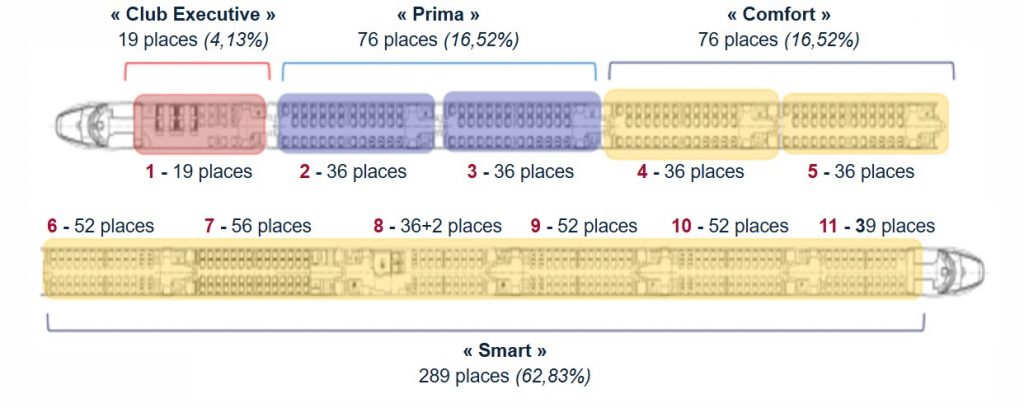
By later, Italo has provide only three travel classes: Club Executive, Prima Business and Smart.
Car 1 – « Club Executive » ambiance

Trainset ETR 575 number 15 in Florence, August 2014 (photo Mediarail.be)
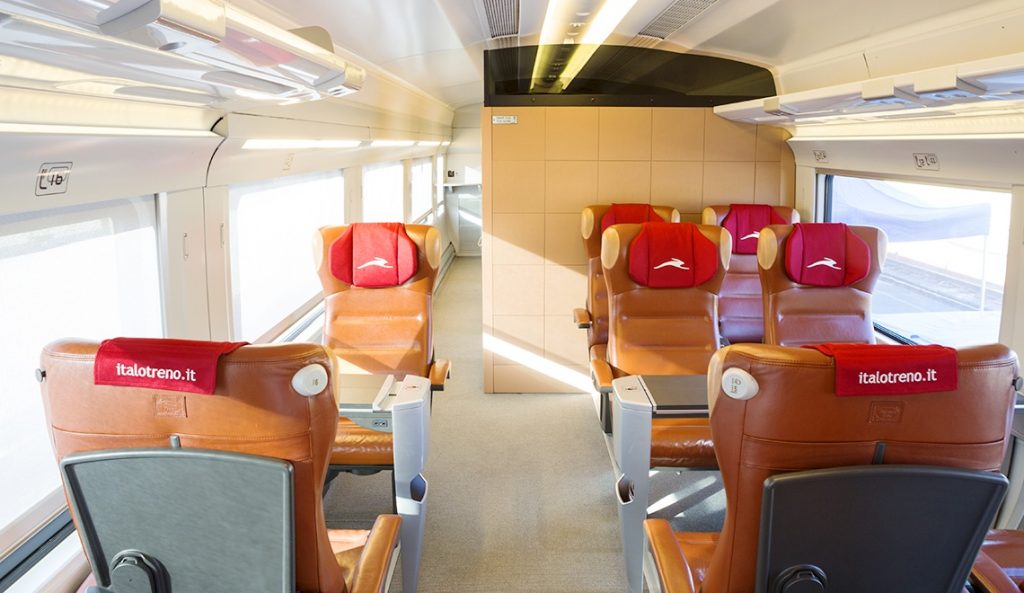
« Club Executive » class. Top of the range comfort (photo press kit from NTV-Italo)

The ‘Club Executive’ cabin
At the top of the range is the ‘Club’ cabin, Italo’s luxury cabin, where 19 passengers can sink into wide, extremely comfortable caramel-coloured Poltrona Frau leather armchairs. Each seat also has a small 9-inch LCD touch-screen TV. Passengers can reserve two four-seater compartments, known as “salottinos”, which can only be fully booked. (photo press kit from NTV-Italo).
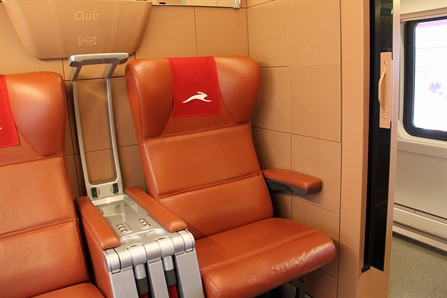
Snacks from the VyTA Santa Margherita caterer are served throughout the journey by a steward or hostess entirely dedicated to the Club. Breakfast is de facto included for journeys between 5:00 and 10:00. When you book an italo Club Executive Class ticket, you benefit from a range of free catering options. The italo homepage describes the offers as ‘espresso coffee and an appetising selection of Italian sandwiches, bakery products and drinks’. In addition, a selection of newspapers and magazines is available, but only in Italian.
Before boarding, Club Executive passengers can use the Club Italo lounges up to 3 hours before departure in Turin Porta Susa, Milan Centrale , Florence SMN , Rome Tiburtina, Rome Termini and Naples Centrale with free coffee and soft drinks and free Wi-Fi connection at the back of Casa Italo.

One of the two “salonttinos” in the “Club Executive” class. An entire lounge for yourself or for 2, 3 or 4 people (photo press kit from NTV-Italo)
Cars 2 and 3 – ‘Prima’ ambiance
This is the equivalent of European first class, with its 2+1 seating configuration. Here, too, customers benefit from free Wi-Fi and power sockets for laptops, cameras and mobile phones.
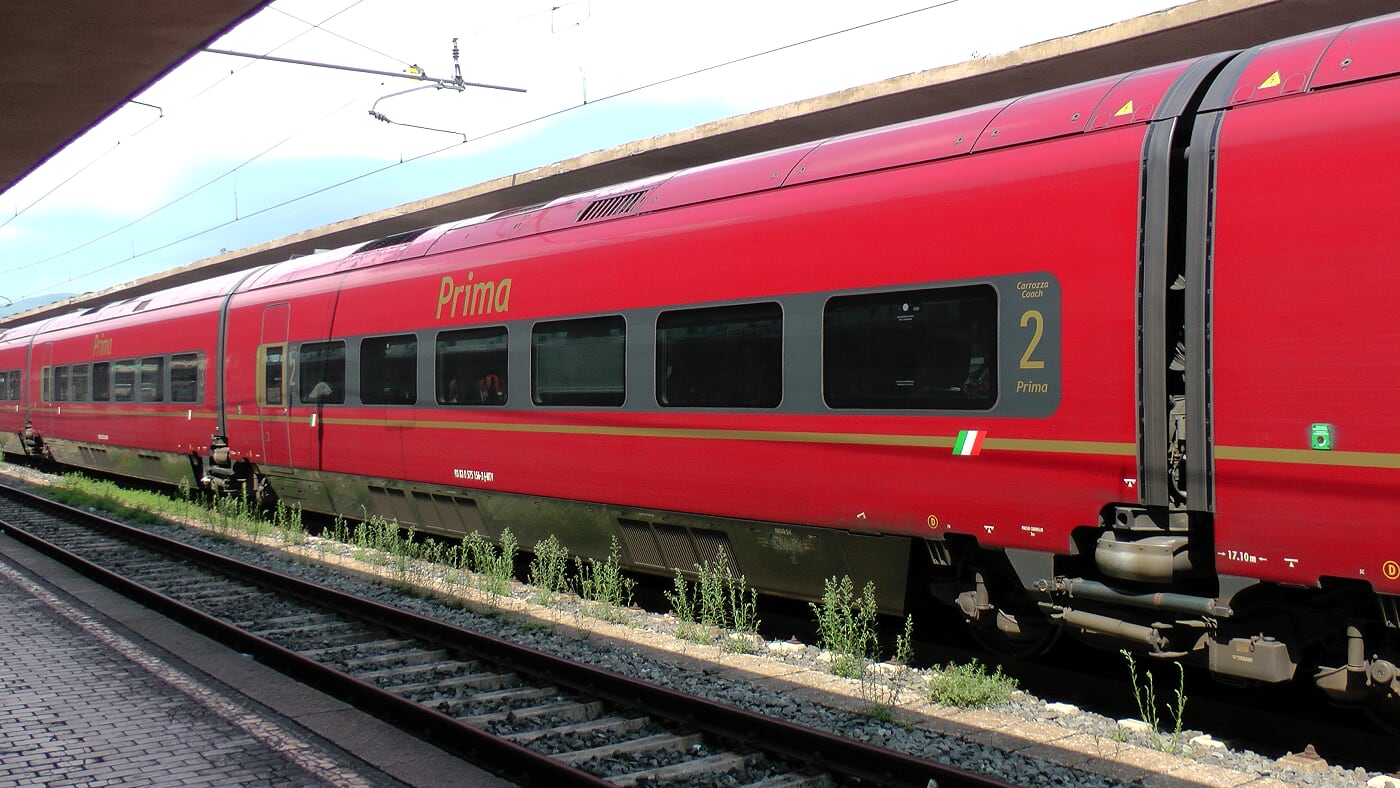
Cars 2 and 3 with ambiance « Prima » (Florence, August 2014, photo Mediarail.be)
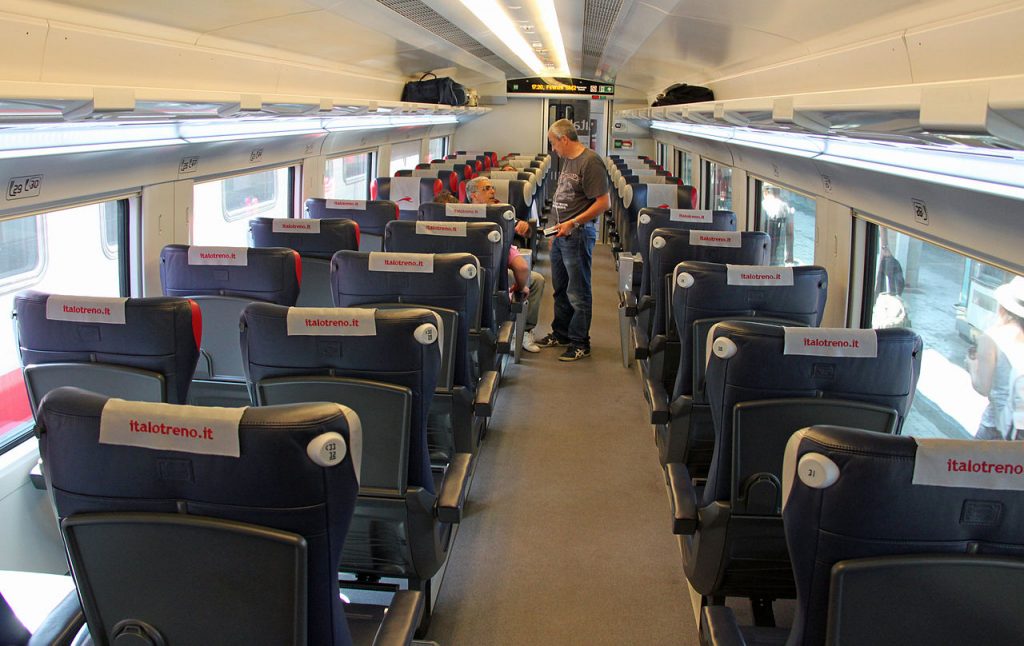
The “Prima” ambience: a classic 2+1 seating arrangement, as used throughout Europe (photo Mauritz90 via wikipedia)
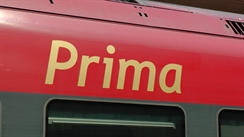
The seats are reclining and for the most part unidirectional, which means there’s plenty of room for individual seating. As you can see on the right, there really are two armrests per seat, which is not the case in the Smart, as we’ll see later. Legroom is also appreciated. NTV-Italo offers many small comforts, including Wi-Fi coverage and free access to the in-car Italo Live portal, so you can enjoy all the entertainment content.
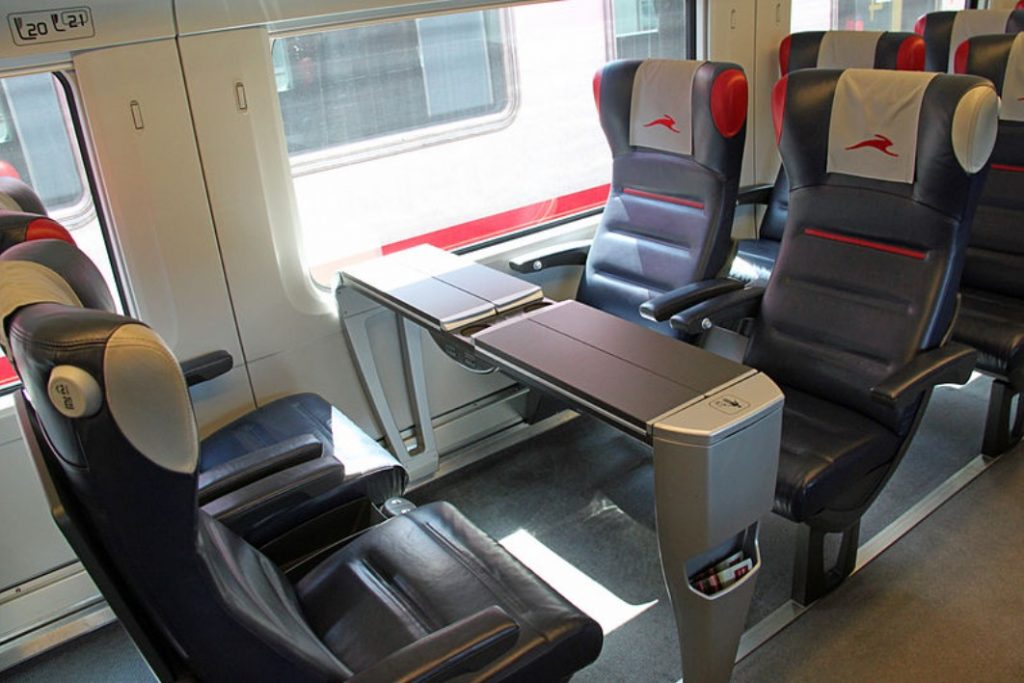
The “Prima” ambience: comfortable. But here with the example of an arrangement that doesn’t match the windows (photo Mauritz90 via wikipedia)
The service allows you to order a meal and receive an Eataly box served at your seat, with the option of pre-ordering when booking. If you book well in advance, the “Prima” atmosphere can be offered at a very reasonable price.

Cars 4 and 5 – « Comfort » ambiance
A detailed analysis of occupancy rates over the years quickly concluded that two Prima ambience cars were too many. Rather than make costly changes to the seats, NTV-Italo left the layout as it was and created a new ‘Smart XL’ ambience, renamed ‘Comfort’ in 2016. For €5 more than the ‘_Smart’ fares, you get a ‘Prima’ seat but without the service that goes with it. The ‘Comfort’ seats are located in cars 4 and 5, not far from the two drinks vending machines in cars 3 and 7. This arrangement was finally abandoned and only the ‘Prima’ class was formed.
Cars 6 to 10 – « Smart » ambiance

One of the « Smart » car, (Florence, August 2014, photo Mediarail.be)

« Smart » ambiance : 249 seats in the traditional 2+2 layout, as used throughout Europe (photo press kit from NTV-Italo)
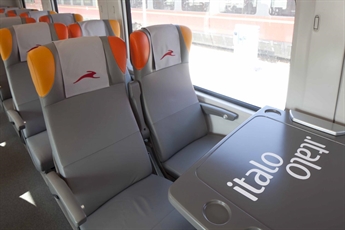
The ‘Smart’ atmosphere
This is the most economical. It has 2+2 split seating, like all the other ‘second classes’ in Europe, with the vast majority of seats being one-way, with only two four-seat squares per car. Customers can take advantage of an entry-level pricing policy. The reclining seats are in Poltrona Frau leather, with good legroom, free Wi-Fi and sockets for laptops, cameras or mobile phones. (photo press kit from NTV-Italo)
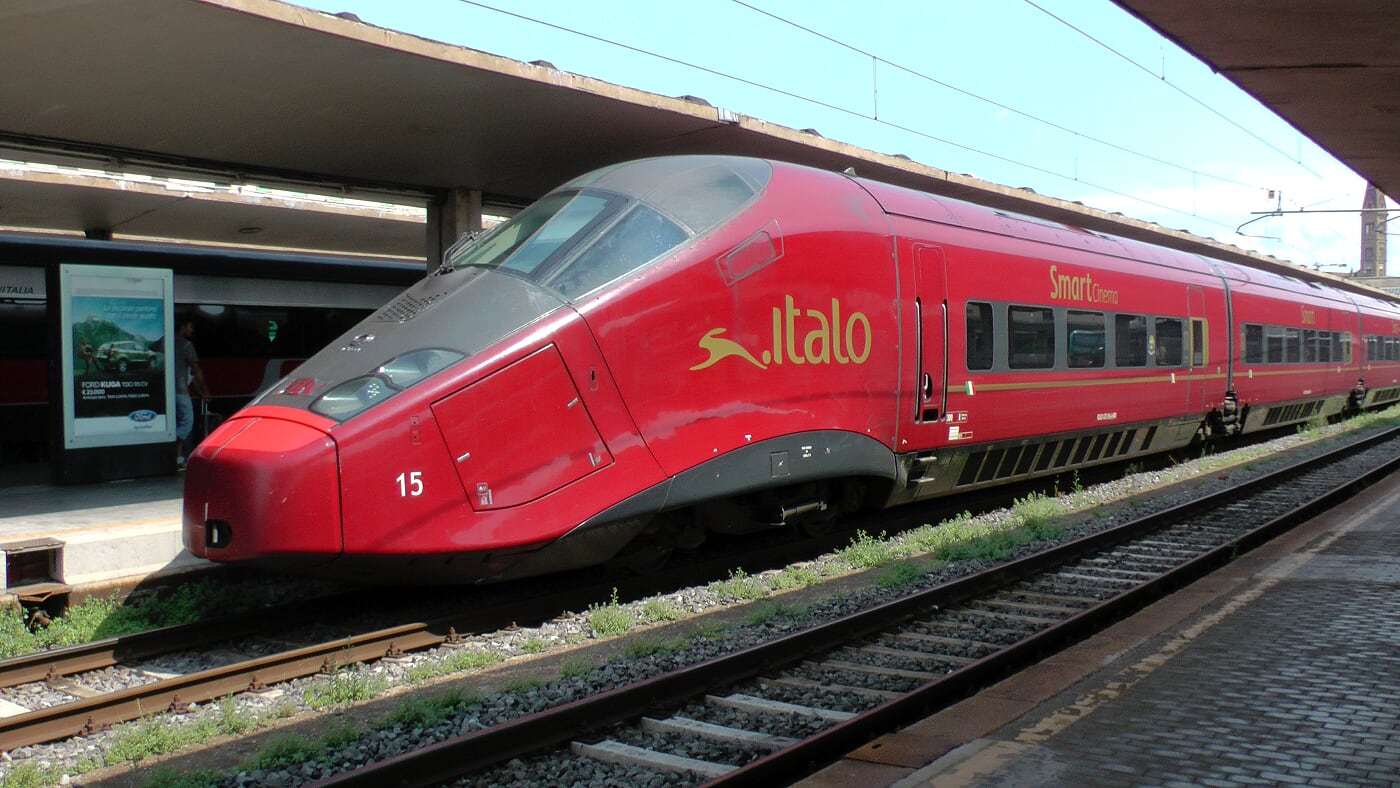
La voiture pilote n°11 propose l’ambiance « Smart Cinema » (Florence, août 2014, photo Mediarail.be)
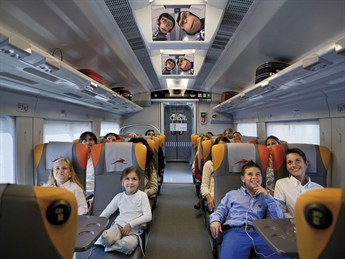
Car 11 – The ‘Smart Cinema’ environment
With 39 seats, this auditorium offers the same level of comfort as the Smart environment and is located at the end of the train, in the 11 pilot car, to avoid too many boring passages. Eight 19-inch screens installed in the ceiling provide weekly programming.

Italo subsequently removed the “Smart Cinema” car from its AGV ETR 575 trains. Currently, Italo AGV’s ETR 575 trains no longer include “Smart Cinema” seats, as on-board entertainment has evolved towards passengers’ personal mobile devices. In their Railjets, the ÖBB also had a very small cinema area, which has also been withdrawn.
Launch and management
On 19 October 2011, NTV-Italo obtained a safety certificate from the Italian National Rail Safety Agency (ANSF) allowing it access to the high-speed lines of the Italian network and certain related lines, such as Florence-Rome, Rome-Cassino-Naples and Rome-Formia-Naples.
The NTV AGV finally entered commercial service in Italy on 28 April 2012, operating under the name ‘Italo’. On 30 March 2013, the entire fleet of 25 ETR 575 trainsets was made available. The maintenance contract with Alstom at the Nola depot provides for the permanent availability of 21 of the 25 trainsets. 🟧
[TOP]
Main line • High speed Rail • Italy • Lexical
